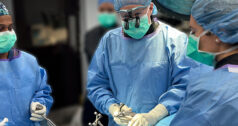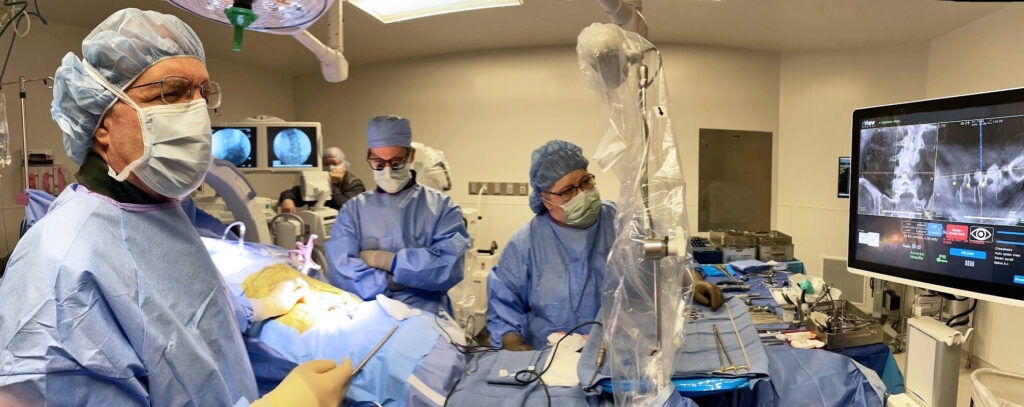
Spine surgery is known for its relative unpredictability. ATEC CEO Pat Miles pointed to a 10% to 15% revision rate after procedures to treat degenerative disc disease to highlight the difficulty in achieving quality outcomes within the specialty.
Robotics and navigation promise predictability, and spine companies believe adding enabling technology to their offerings is an essential element of competing at the top of the market. Look no further than one of the largest players in the industry for evidence of that reality.
Stryker CEO Kevin Lobo attributed his company’s middling performance in the spine market in 2023 to its lack of a robot in the space. He said the company’s expected launch of the Mako Spine platform in 2024 will help Stryker realize above-market growth.
Will that growth be driven by marketing campaigns or surgeon adoption? According to ORTHOWORLD reporting, less than 20% of spinal fusion procedures use navigation, while robotic procedures in spine are in the low single digits.
Neo Medical’s founder and Co-CEO Vincent Lefauconnier said robotics currently brings limited long-term clinical advantages to spine procedures. “The technology, as it stands now, will remain a niche product with little ability to significantly shift the market,” he said.
Lefauconnier also pointed to the expense of robots and lack of intuitive use as barriers to their widespread adoption. He believes value can be found in digital tools that improve access to intraoperative data and analysis and guidance systems that support surgeons in developing and delivering optimized treatments for individual patients. As such, he pointed to the importance of more accessible, affordable technologies such as augmented reality (AR) navigation.
“The spine market is seeing the emergence of streamlined imaging systems, navigation and AR platforms,” Lefauconnier said. He predicts that AI-driven navigation, which he said offers a technological advantage at a much lower cost than competing systems, will ultimately benefit from this trend.
Better Outcomes in Less Time
Published data shows that traditional imaging technologies and surgical approaches used for thoracolumbar fusion result in a 20% revision rate in the first two years post-op, according to Lefauconnier. He said revision rates increase to 40% over the long term and have been trending upward over the last 10 years. He also noted that implant failure is the leading cause of revision surgery, with about 70% of failures caused by mechanical stress.
With those dire stats in mind, Neo Medical sought to find a more exact way to provide surgeons with real-time surgical guidance that they can use to place implants precisely to reduce mechanical stress on the devices.
The company’s ADVISE is an AI-driven AR platform that is deployed with an iPad. It works in concert with Neo Medical’s Pedicle Screw System to help surgeons perform thoracolumbar fusion surgery through real-time access to data, analysis and application guidance. “No other system provides surgeons with intraoperative data in this way,” Lefauconnier said. “The iPad interface is easy to use, with most surgeons getting up to speed with the platform in a few minutes.”
hen leveraging technology to insert a rod, for example, Lefauconnier said ADVISE uses exact real-world data to help surgeons minimize offsets between support rods and the pedicle screws that hold them in place. Surgeons use ADVISE to determine the precise relationship between the screws and rod implants. The system generates an accurate rod template based on an entirely objective analysis of the positioning.
“The rods hold the spine in position as it heals, so it must be exactly the right shape for each patient,” Lefauconnier said. “Data guidance can help surgeons contour the rods in the most effective way possible, creating a physical support that will help to reposition the patient’s anatomy in a more balanced and stable way.
“It’s this offset that causes many of the complications that ultimately lead to implant failure, necessitating a second, third or even fourth revision surgery,” he explained. “A misalignment of just a few millimeters can lead to damaging stress forces of hundreds of pounds of pressure being placed on the construct and the patient’s anatomy.”
Lefauconnier said digital technology has improved spine surgery in many ways, not the least of which is reducing the time patients spend under anesthesia. ADVISE provides access to data for targeted spine treatments that reduce surgical times, meaning patients are less likely to suffer surgical site infections and can recover faster from procedures. It also means surgeons can treat more patients in less time.
“Reducing surgical times has a direct impact on overall costs of care — every minute saved is beneficial,” Lefauconnier explained. “What’s more, we’re delivering these time-savings in a way that improves patient outcomes. It’s a win/win.”

Dr. Kevin Foley uses the nView s1 3D system to plan a surgical trajectory.
Leading By Example
A major component of digital technology is that it can provide important decision-support capabilities during a wide range of commonly performed spine surgeries. This means that surgeons can use information to plan procedures more accurately, identify critical structures and navigate through the spine with increased accuracy to guide the placement of implants and ensure optimal alignment.
AR technology overlays digital information onto the surgeon’s field of view, providing real-time guidance and feedback during procedures. Digital tools can also analyze large datasets of patient outcomes and surgical techniques to identify predictive factors that lead to improved outcomes.
A recent example is the ORLenz AR/XR headset developed by Ocutrx Technologies, maker of AR, XR and 3D technology for medical applications. The headset is currently used by surgeons at Cedars-Sinai Spine Centers in Los Angeles in place of conventional optical surgical loupes. The ORLenz provides a digital alternative with higher resolution and much greater magnification than traditional imaging systems, according to Ocutrx.
The headset displays 3D holographic images of the surgery site with up to 10x magnification. Simon Prosser, Global Director of Surgical Applications at Ocutrx, said that the development of the headset marks a shift in the way surgeons view spine surgery. “We’re excited about the potential to transform precision and surgeon comfort, not only for spine but also other disciplines in the future,” he said.
Earlier this year at Semmes Murphey Clinic in Memphis, surgeons performed the first successful adult spine surgery using nView’s s1 imaging and navigation system, a solution that deploys rapid 3D imaging to help surgeons accurately place spine implants.
Kevin Foley, M.D., the primary surgeon during the case, used the system during an outpatient minimally invasive transforaminal lumbar interbody fusion. He credited s1’s 3D imaging technology with allowing him to deliver faster imaging and automatic registration without exposing the spine. Dr. Foley said the platform is well-suited for ASCs; nView Medical has been focused on creating solutions for such sites of care throughout the beta testing and development of the s1 platform.
Cristian Atria, founder and CEO of nView, said the company’s goal is to make advanced minimally invasive procedures safer and more accessible, and provide low-dose and highly efficient intraoperative imaging and surgical guidance to more patients.
Late year Jonathan Hyde, M.D., completed what’s reportedly the first-ever navigated minimally invasive lumbar fusion performed in an ASC using Captiva Spine’s WatchTower Spine Navigation. The system features rapid instrument verification and registration, a small footprint and intuitive touchscreen controls — features that make it appealing for use in outpatient settings.
The system employs 3D navigation to guide surgeons during lumbar fusion and sacroiliac joint fusion surgery. This allows surgeons to navigate instruments and implants with enhanced accuracy while eliminating the need for C-arm intraoperative imaging, a factor that reduces the risk of radiation exposure to patients and staff.
Dr. Hyde explained that eliminating surgical disruption and delays is one of the most important aspects of the WatchTower navigation system, most notably by negating the need for intraoperative CT scanning and open touch and photographic registration. “The navigation capabilities offer a degree of intraoperative clarity and guidance that will benefit even the most capable surgeons,” he said.
Last May, Captiva Spine received FDA 510(k) clearance to market WatchTower ROAM, a compact version of the standard WatchTower platform. ROAM is easy to transport to various sites of care throughout a community, allowing surgeons to work with the technology in whichever facility they perform surgery. The platform was also FDA-cleared for use with 9- and 12-inch image intensifiers, making the system compatible with more types of C-arms that are in use in various surgical facilities.
Captiva Spine said ROAM is a significant advancement towards navigation becoming a more practical standard of care through accessibility and affordability to previously underserved facilities.
The Future Looks Digital
Lefauconnier said that digital platforms have already been well received by spine surgeons and have been proven to make a positive difference in patient outcomes by solving clinical shortcomings and integrating seamlessly with surgical workflows to augment current techniques.
One of the most important aspects of new digital technology for spine surgery is how platforms contribute to the development of effective minimally invasive surgical approaches that let surgeons perform complex procedures through smaller incisions, resulting in improved recovery times, reduced infection risks and less damage to surrounding tissue.
Better and even more easily operable solutions are being developed to aid spine surgeons. Questions surround what digital surgical tools will not only look like, but how they will continue to change the spine landscape in coming years. It’s up to developers of the technologies and their imaginations to decide what could come next.
It can be easily assumed that AI and AR and even virtual reality (VR) will play significant future roles in how spine surgery is performed. AI algorithms, for example, could process and analyze vast amounts of data to create personalized treatment plans for individual patients. Data analytics and machine learning could be used to identify predictive factors during each surgery that improve outcomes. This will help surgeons make much more informed decisions that lead to improved patient care.
VR systems will allow surgeons to immerse themselves in virtual environments to practice complex procedures and rehearse actual surgical plans. Advancing AR platforms will continue to be a cost-effective navigation option, especially as more spine cases move to ASCs.
When you consider how quickly surgery has moved from analog to digital solutions, it’s easy to imagine how far spine will evolve in the future.
Lefauconnier believes companies have only begun to scratch the surface of what’s possible. “Digital technology will develop rapidly as companies continue to address concerns about cost, capital equipment acquisition and complexity of use,” he said.
NHM
Natalie Hope McDonald is a contributing editor.




